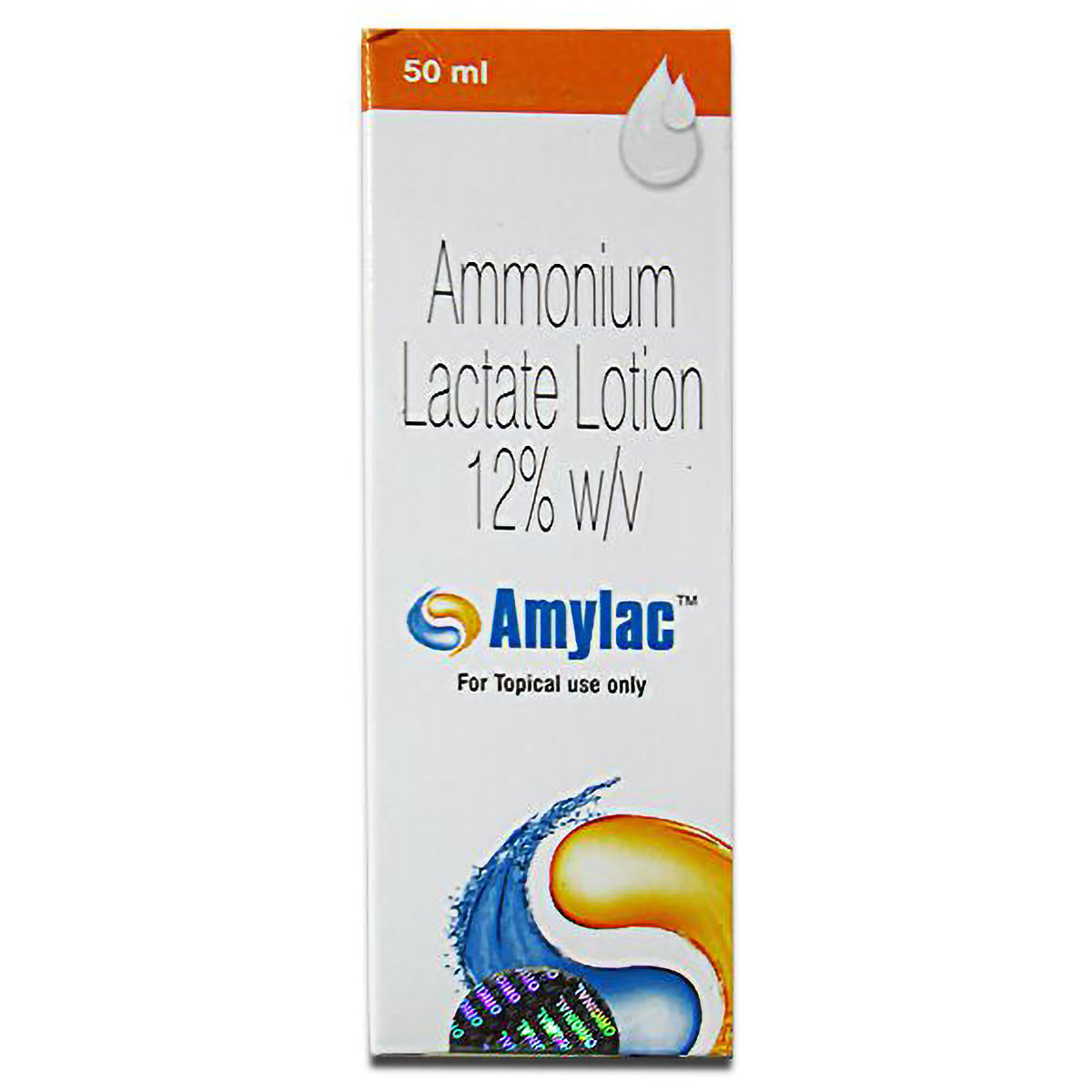Amylac Lotion 50 ml

MRP ₹136
(Inclusive of all Taxes)
₹20.4 Cashback (15%)
Know Your Delivery Time
Provide Delivery Location

Secure Payment

India's Most Trusted Pharmacy

Genuine Products
Composition :
Manufacturer/Marketer :
Consume Type :
Return Policy :
Expires on or after :
About Amylac Lotion
The Amylac Lotion belongs to the class of medications called 'alpha-hydroxy acids' primarily used to treat xerosis (dry or scaly skin) and ichthyosis Vulgaris (an inherited dry skin condition) in adults and children. And it can also help relieve itching from these conditions.
Amylac Lotion contains lactic acid and ammonium hydroxide. Amylac Lotion acts as a moisturizer and works by increasing skin hydration. And thereby relieving the symptoms of dry or scaly skin and dry skin.
Amylac Lotion comes as a cream and a lotion to apply to the skin. Amylac Lotion is for external use only. It is usually applied to the affected skin area twice daily. Apply gently at around the same time(s) every day. Follow the directions on your prescription label carefully. Apply Amylac Lotion exactly as directed. Please do not use it more or less or use it more often than your doctor prescribed. Amylac Lotion has common side effects, as every medicine does. These include rash (including erythema and irritation) and burning/stinging. These side effects gradually resolve during the treatment and do not require medical attention.
Do not use if hypersensitivity to any of the ingredients is noted. Sun exposure to areas of the skin treated with Amylac Lotion Cream should be minimized or avoided. Brief your medical history to the doctor. This medication is to be used as directed by the physician and should not be used for any disorder other than it was prescribed. It is for external use only. Avoid contact with eyes, lips, or mucous membranes.
Uses of Amylac Lotion
Amylac Lotion used in the treatment of Xerosis (dry or scaly skin) and Ichthyosis Vulgaris (an inherited dry skin condition). The detailed uses of Amylac Lotion are as follows:
- Xerosis Treatment: Amylac Lotion relieves dry, itchy, and scaly skin, improving hydration and comfort.
- Ichthyosis Management: Amylac Lotion helps to manage dry, thickened skin, reducing scaling and improving skin texture.
- Moisturization and Skin Barrier Repair: Amylac Lotion provides intense hydration, softens the skin, and helps restore its natural moisture barrier, promoting healthier-looking skin.

Have a query?
Directions for Use
- Follow your doctor's instructions on the dosage and timing of this medication to ensure safety.
- Take a small amount of Amylac Lotion on the fingertip and apply it as a thin layer on the clean and dry affected area as directed by your doctor.
- Wash your hands after using Amylac Lotion unless your hands are the affected area.
Medicinal Benefits
Amylac Lotion contains lactic acid and ammonium hydroxide. Amylac Lotion acts as a moisturizer, and it works by increasing skin hydration and thereby relieving the symptoms of dry or scaly skin and dry skin.
How Amylac Lotion Works
Storage
What if I have taken an overdose of Amylac Lotion
Drug Warnings
Do not use if you are hypersensitive to any of the ingredients is noted. Sun exposure to areas of the skin treated with Amylac Lotion Cream should be minimised or avoided. Brief your medical history to the doctor. This medication is to be used as directed by the physician and should not be used for any disorder other than for which it was prescribed. It is for external use only. Avoid contact with eyes, lips, or mucous membranes. Please consult your doctor if you are pregnant or planning to conceive before using Amylac Lotion. Let your doctor know if you are a nursing mother before using Amylac Lotion.
Diet & Lifestyle Advise
- Use mild soap while taking baths and prefer warm baths.
- Avoid harsh products on your skin.
- Do not scratch or pick your skin to avoid getting the affected area infected.
- Manage stress, eat healthily, drink plenty of water, exercise regularly, and get plenty of sleep.
- Do not walk barefoot at places like gym showers to prevent bacterial infections.
Habit Forming
Therapeutic Class
Alcohol
Caution
It is advisable to avoid or limit the intake of alcohol while you use Amylac Lotion.
Pregnancy
Caution
Pregnancy Category B: Amylac Lotion should not be taken until prescribed. Your doctor will weigh the benefits and any potential risks before prescribing it to you. Please consult your doctor.
Breast Feeding
Caution
Please consult your doctor for advice before using Amylac Lotion. It is unknown to what extent this drug affects normal lactic acid levels in human milk. Caution should be exercised when Amylac Lotion is administered to a nursing woman.
Driving
Safe if prescribed
Amylac Lotion is generally safe to use before driving. However, if you notice any side effects like dizziness or burning sensation in the affected areas, avoid driving and operating machinery until you feel better.
Liver
Safe if prescribed
Inform your doctor before receiving the Amylac Lotion if you have a liver impairment/disorder history. Your doctor will prescribe only if the benefits outweigh the risks.
Kidney
Safe if prescribed
Inform your doctor before receiving the Amylac Lotion if you have a kidney impairment/disorder history. Your doctor will prescribe only if the benefits outweigh the risks.
Children
Caution
The safety and effectiveness of Amylac Lotion cream have been established in pediatric patients as young as 2 years old.
Heart
Inform your doctor if you have any existing heart disease. Your doctor will prescribe this medicine only if the potential benefits outweigh the risks.
Geriatrics
Caution
Amylac Lotion should be used with caution in elderly patients due to an increased risk of side effects. Seek medical advice before using Amylac Lotion.
FAQs
Amylac Lotion is used to treat xerosis (dry or scaly skin) and ichthyosis Vulgaris (an inherited dry skin condition).
Amylac Lotion contains lactic acid and ammonium hydroxide. And it works by increasing skin hydration. And thereby relieves the symptoms of dry or scaly skin and dry skin.
You can consume any food or beverage normally while taking Amylac Lotion. However, it is advised to reduce the intake of beverages like alcohol while on medication.
The usual recommendation of dosage for Amylac Lotion can be for a short time. However, your doctor may prescribe it for a longer time, depending on your skin condition.
Sun exposure to areas of the skin treated with Amylac Lotion should be minimized or avoided.
Country of origin
Manufacturer/Marketer address
Disclaimer
Author Details
We provide you with authentic, trustworthy and relevant information
Buy best Dermatology products by
Others
AYUR
MINTOP
Venusia
UV DOUX
KETO
ELOVERA
NEVLON
TUGAIN
FIXDERMA
ONABET
SELSUN
SOLSET
UVAVO
BETADINE
CANDID
MINOIL
KETAFUNG
MOISTUREX
REJUGLOW
TRICOMAX
TRUDERMA
ACTAME
BIOLINE
CLOCIP
Canesten
DERMADEW
KENZ
KETOMAC
MELALUMIN
OLESOFT
SLC
ZENSOFT
ZORAY
ECOKET
MELAGARD
MORR
NIXIPER
PHOTON
REJUHAIR
SUDERMA
SUNSTOP
AQUASOFT
CIPHANDS
CLINSOL
CUVIA
DEWDERM
DEWSOFT
DUCRAY
DYSIS
EKRAN
KETOL
LOZISOFT
MESODEW
MINOPEP
OILATUM
PARASOFT
PMT
SOLASAFE
SUNBAN
SUNCROS
ACCARE
ACMED
BLYNDS
COSALIC
DANCLEAR
DEPISHINE
Evion
GLAMBAK
GLYMED
HAIRGUARD
Hair Shield
ISDIN
KETOPZ
KTC
KZ
L-SKIN
LACNE
MEDERMA
MEDILICE
PERITOP
PERMED
PHOTOSTABLE
PHYSIOGEL
PSOROLIN
Q-SERA
RITCH
SOFIDEW
SUNMATE
TRIRISE
TVAKSH
ULTRA
UNISON
YUVINIE
A-DERMA
ACNE-UV
ACNESTAL
ACNESTAR
ACNETHRO
ADCROSS
Glenmark Pharmaceuticals Ltd
Canixa Life Sciences Pvt Ltd
Klm Laboratories Pvt Ltd
Sun Pharmaceutical Industries Ltd
Cipla Ltd
Intas Pharmaceuticals Ltd
Abbott India Ltd
Ajanta Pharma Ltd
East West Pharma India Pvt Ltd
Dr Reddy's Laboratories Ltd
Brinton Pharmaceuticals Ltd
Leeford Healthcare Ltd
Alkem Laboratories Ltd
Skinocean Pharmaceuticals
Amwill Healthcare Pvt Ltd
Atopic laboratories Pvt Ltd
Hegde & Hegde Pharmaceutica Llp
Torrent Pharmaceuticals Ltd
Palsons Derma Pvt Ltd
Dermacia Healthcare
Oaknet Healthcare Pvt Ltd
Ipca Laboratories Ltd
Micro Labs Ltd
Yaher Pharma
Med Manor Organics Pvt Ltd
Dermocare Laboratories Gujarat Llp
Apex Laboratories Pvt Ltd
Talent India Pvt Ltd
Kivi Labs Ltd
Mankind Pharma Pvt Ltd
Systopic Laboratories Pvt Ltd
Menarini India Pvt Ltd
Nemus Pharmaceuticals Pvt Ltd
Ethinext Pharma
Zydus Cadila
Regaliz Medicare Ltd
Inex Medicaments Pvt Ltd
Mohrish Pharmaceuticals Pvt Ltd
Hbc Dermiza Healthcare Pvt Ltd
Lupin Ltd
Mrhm Pharma Pvt Ltd
Zydus Healthcare Ltd
Eskon Pharma
GlaxoSmithKline Pharmaceuticals Ltd
La Pristine Bioceuticals Pvt Ltd
Praise Pharma
Wallace Pharmaceuticals Pvt Ltd
Newtrimed Healthcare Pvt Ltd
Biocute Life Care
Glowderma Lab Pvt Ltd
Macleods Pharmaceuticals Ltd
Sol Derma Pharmaceuticals Pvt Ltd
Aurel Biolife
Ethicare Remedies Pvt Ltd
Galcare Pharmaceuticals Pvt Ltd
Kaizen Drugs Pvt Ltd
Percos India Pvt Ltd
Rockmed Pharma Pvt Ltd
Elder Pharmaceuticals Ltd
Rely On Pharmaceuticals
Wockhardt Ltd
Zee Laboratories Ltd
Karlin Pharmaceuticals & Exports Pvt Ltd
Alniche Life Sciences Pvt Ltd
Connote Healthcare
La Med Healthcare Pvt Ltd
Prism Life Sciences Ltd
Yap Bioceuticals
P and P Dermaceuticals Pvt Ltd
Adonis Laboratories Pvt Ltd
Indiabulls Pharmaceuticals Pvt Ltd
Lyra Laboratories Pvt Ltd
Akumentis Healthcare Ltd
Albatross Healthcare Pvt Ltd
Apple Therapeutics Pvt Ltd
Arka Vital Science Pvt Ltd
Gary Pharmaceuticals Pvt Ltd
Rhine Biogenics Pvt Ltd
Yash Pharma Laboratories Pvt Ltd
Dermajoint India
Leogard Pharmaceuticals Pvt Ltd
Dermarex HealthCare India Pvt Ltd
Iceberg Health Care Pvt Ltd
Capital Pharma
Eumedica Pharamceuticals
FDC Ltd
Glasier Wellness Inc
Grace Derma Healthcare Pvt Ltd
Oziel Pharmaceuticals Pvt Ltd
Salve Pharmaceuticals Pvt Ltd
West Coast Pharmaceuticals Pvt Ltd
Entod Pharmaceuticals Ltd
Jenburkt Pharmaceuticals Ltd
Medcure Organics Pvt Ltd
Olcare Laboratories Pvt Ltd
Anhox Healthcare Pvt Ltd
Bioswizz Pharmaceuticals Ltd
Indchemie Health Specialities Pvt Ltd
Omniceutics Healthcare Pvt Ltd
Skinska Pharmaceutica Pvt Ltd
BODY CREAM
Body Lotion
Soap
Face Cream
Shampoo
Sun Screen
Face Gel
Face Wash
HAIR SOLUTION
BODY GEL
Face Serum
Hair Lotion
Hair Serum
Dusting Powder
ANTISEPTIC
Body Wash
Face Lotion
FACE CLEANSER
Body Spray
Foot Cream
Conditioner
Eye Cream
Eye Gel
Cleanser
Hair Cream
Hair Gel
Hair Spray
FUNGAL INFECTION
Hair Oil
Sanitizer
Specialty Supplements
Face Mask
Skin Ointment
Lip Balm
Capsule
Eye Serum
Intimate Wash
Hand Cream
Facial Spray
Face Toner
Hand Wash
SPECIALITY SUPPLEMENT
Tablet
BABY SUNSCREEN
Body Butter
Body Scrub
EYE SOLUTION
FACIAL WIPE
Gargle
Hair Color
Hair Mask
Hair Tonic
Intimate Spray
Lip Serum
VITAMIN D





